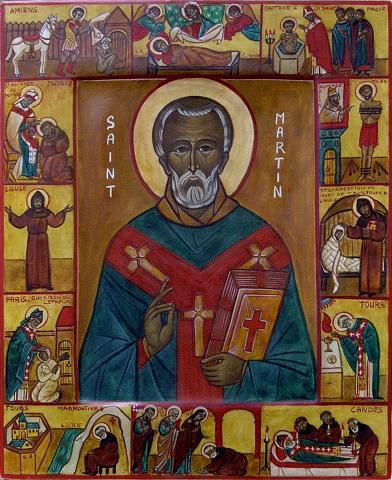Martin the Merciful, bishop of Tours, holy hierarch
Dates of commemoration
(Church calendar - Oct 12)
Life
Saint Martin the Merciful, Bishop of Tours, was born at Sabaria in Pannonia (modern Hungary) in 316. Since his father was a Roman officer, he also was obliged to serve in the army. Martin did so unwillingly, for he considered himself a soldier of Christ, though he was still a catechumen.
At the gates of Amiens, he saw a beggar shivering in the severe winter cold, so he cut his cloak in two and gave half to the beggar. That night, the Lord Jesus Christ appeared to the saint wearing Martin’s cloak. He heard the Savior say to the angels surrounding Him, “Martin is only a catechumen, but he has clothed Me with this garment.” The saint was baptized soon after this, and reluctantly remained in the army.
Two years later, the barbarians invaded Gaul and Martin asked permission to resign his commission for religious reasons. The commander charged him with cowardice. Saint Martin demonstrated his courage by offering to stand unarmed in the front line of battle, trusting in the power of the Cross to protect him. The next day, the barbarians surrendered without a fight, and Martin was allowed to leave the army.
He traveled to various places during the next few years, spending some time as a hermit on an island off Italy. He became friendly with Saint Hilary, Bishop of Poitiers (January 14), who made Matrin an exorcist. After several years of the ascetic life, Saint Martin was chosen to be Bishop of Tours in 371. As bishop, Saint Martin did not give up his monastic life, and the place where he settled outside Tours became a monastery. In fact, he is regarded as the founder of monasticism in France. He conversed with angels, and had visions of Saints Peter and Paul (June 29) and of other saints. He is called the Merciful because of his generosity and care for the poor, and he received the grace to work miracles.
After a life of devoted service to Christ and His Church, the saint fell ill at Candes, a village in his diocese, where he died on November 8, 397. He was buried three days later (his present Feast) at Tours. During the Middle Ages, many Western churches were dedicated to Saint Martin, including Saint Martin’s in Canterbury, and Saint Martin-in-the-Fields in London.
In 1008, a cathedral was built at Tours over the relics of Saint Martin. This cathedral was destroyed in 1793 during the French Revolution, together with the relics of Saint Martin and Saint Gregory of Tours (November 17). A new cathedral was built on the site many years later. Some fragments of the relics of Saint Martin were recovered and placed in the cathedral, but nothing remains of Saint Gregory’s relics.
Saint Martin’s name appears on many Greek and Russian calendars. His commemoration on October 12 in the Russian calendar appears to be an error, since ancient sources give the November date.
Source:
https://oca.org/saints/lives/2017/10/12/205432-st-martin-the-merciful-the-bishop-of-tours
Holy relic type
unless specified otherwise below, "holy relic" means a fragment of a bone of the saint
Holy relic
Location of the holy relic in the Cathedral:
Relics cabinet in the Altar sacristy, reliquary #9
Troparion
Тропарь святителю, глас 4
Правило веры и образ кротости воздержания учителя яви тя стаду твоему яже вещей истина; сего ради стяжал еси смирением высокая, нищетою богатая, отче священноначальниче Мартине, моли Христа Бога спастися душам нашим.
Kontakion
Кондак святителю, глас 2
Божественный гром, труба духовная, веры насадителю и отсекателю ересей, Троицы угодниче, великий святителю Мартине, со Ангелы предстоя присно, моли непрестанно о всех нас.






